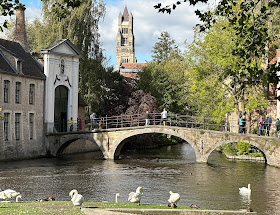Thursday 3 October 2024
Walls create borders, bridges create solutions.
But my camera roll has far more images of stunning bridges than imposing walls so, as promised, here’s a selection of some of the beautiful bridges (and a couple of not so beautiful ones) that we’ve either deliberately sought out or unexpectedly come across on our trip through Turkey, Greece and Albania.
Turkey
The 1915 Canakkale Bridge was opened in 2022 and, at 2023 meters, it became the longest suspension bridge in the world. We previously used to take a little ferry to cross the Dardanelles Strait - although the bridge is cheaper and quicker, the experience isn’t half as much fun.
Northern Greece
The Zagori region is supposedly home to more than 150 arched stone bridges built during the 18th and 19th centuries. Many were funded by local philanthropists and master craftsmen used local stone to build them. Most are still standing, albeit many have been repaired and renovated over the years.
I’m going to throw the Santa Maura Floating Bridge in here which connects mainland Greece to the ‘island’ of Lefkada. Over the past 100 years the type of bridge/ferry used to cross the man-made channel has changed enormously. This particular floating/swinging bridge has been in situ since 1986 and swings open roughly every hour on the hour and stays open for about 15 minutes to let boats pass through.
Albania
Dragot Bridge, built in 1936, which crosses the River Vjosa was described on a tourist information board nearby as ‘probably the most beautiful bridge in Albania’.
At the time we said to each other ‘We’ll be the judge of that’ as we’d already seen the beautiful ancient stone Katiu bridge and would later see Mesi bridge, with its 13 arches.
The Zogu Bridge in central Albania was built in 1927 and was hailed as a masterpiece of civil engineering for its time. It was designed by German and Swiss engineers and built using imported Italian materials. Sadly it hasn’t fared well - one of its six arches was bombed in WW2 and another column, supporting two arches, is sinking into the river bed. We walked over it despite reading that it was ‘in imminent danger of collapse’. It might have survived better if it had been designed by Italians and built with German and Swiss materials!
Heading Home
With a few hours to spare before our ferry home we parked up on the outskirts of Brugge and walked into the city centre. It is one of 37 towns and cities in Europe affectionately referred to as the ‘Venice of the North’ (8 of them being in the UK!). Depending on which website you read there are between 50 and 80 bridges in Brugge, some romantic, all functional. A real mix of wooden, stone and metal structures, some swinging, some lifting, some fixed. We managed to walk over quite a few of them in the very short time we were there.

















No comments:
Post a Comment